In the dynamic landscape of Software as a Service (SaaS), how you introduce your product to the world can be just as vital as the product itself. We like to say “No amount of mediocre marketing can propel a great product to achieve widespread adoption”.
Your go-to-market (GTM) strategy can be the catalyst that propels your startup from “my product is great, but no one knows about it” to a unicorn. In this blog post, we’ll journey through the ins and outs of SaaS GTM strategies, providing actionable tips and real-world examples of SaaS marketing campaigns.
Let’s get started.
How to market a SaaS product?
Every SaaS startup embarks on a thrilling ride from Launch to Lift to Leverage. This journey from introducing your brainchild to the world (Launch), to accelerating its growth (Lift), to finally optimizing and expanding your success (Leverage), is packed with opportunities and challenges.
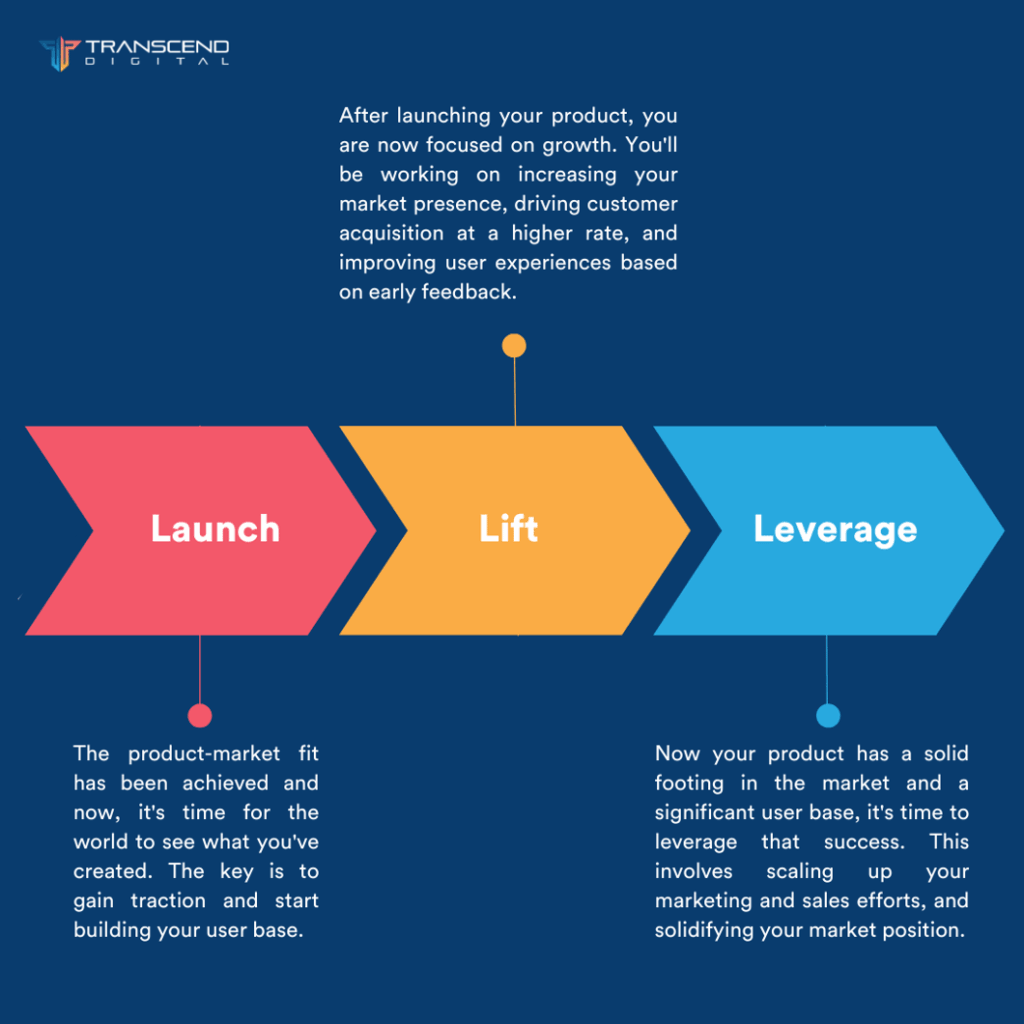
Want to dive deeper? We’ve put together a nifty cheat sheet for you. It provides a detailed breakdown of recommended marketing tactics tailored to each growth stage. You can grab a copy of Startup Growth Marketing Roadmap Cheat Sheet right here.
What is SaaS marketing?
SaaS marketing refers to the strategies and tactics a SaaS (Software as a Service) company uses to acquire, retain, and expand its user base. It’s often focused on demonstrating the product’s value, reducing churn, increasing customer lifetime value, and promoting user engagement.
How is SaaS marketing different?
- SaaS businesses operate on a subscription model, which means marketing isn’t about making a one-time sale.
- With SaaS, the products are often complex and require a good understanding to use effectively.
- SaaS marketing is heavily reliant on metrics, such as Monthly Recurring Revenue (MRR), Customer Acquisition Cost (CAC), Churn Rate, Lifetime Value (LTV), and many others. Learn more about the key SaaS metrics and benchmarks here.
How much do SaaS companies spend on marketing?
SaaS companies, particularly in their growth phase, tend to spend a significant proportion of their revenue on sales and marketing. The exact figure can vary widely, but many SaaS businesses might spend between 7% and 15% of their revenue on marketing, sometimes even more, depending on their go-to-market strategy and market dynamics.
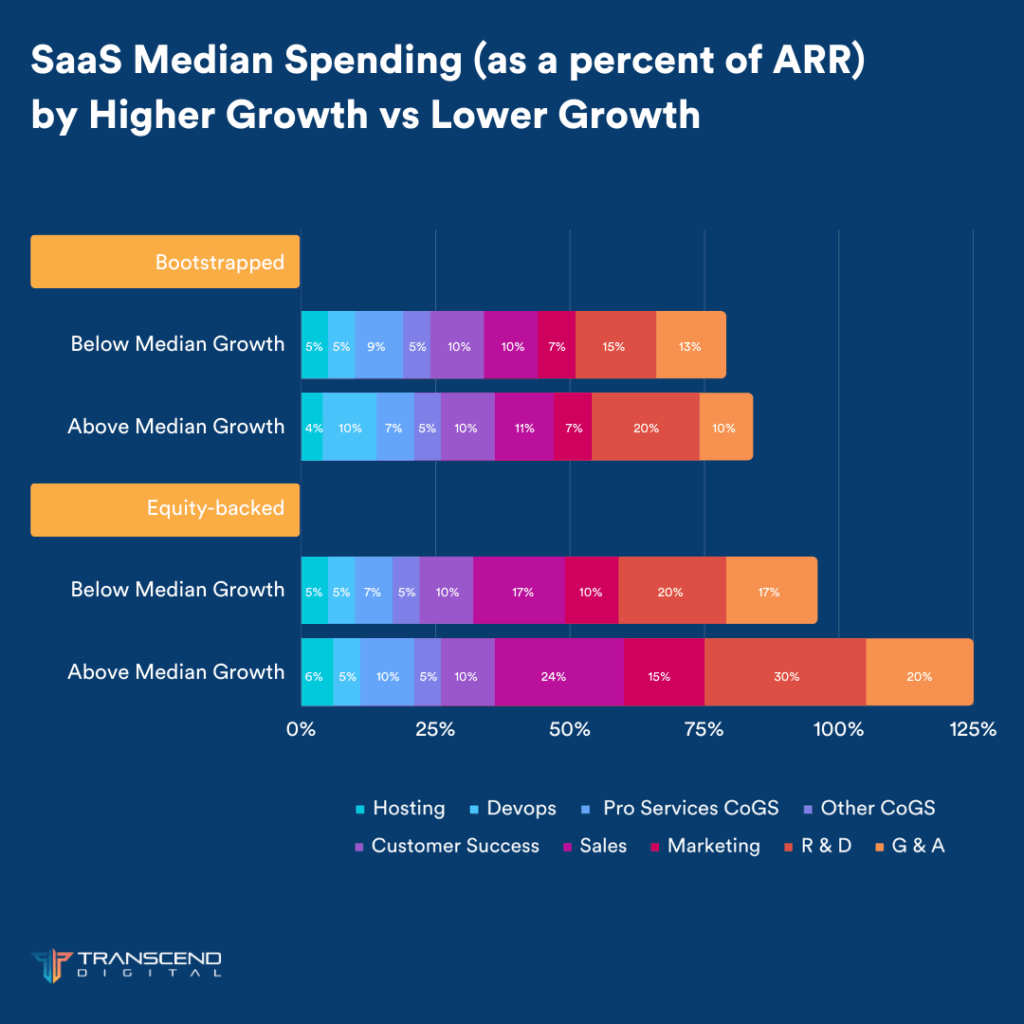
Source: www.saas-capital.com
Keep in mind, your marketing budget shouldn’t be a standalone number. It’s best to look at it through the prism of your LTV (Lifetime Value) and CAC (Customer Acquisition Cost). In the SaaS universe, it’s quite common to aim for an LTV:CAC ratio of 3:1. This is often seen as a healthy balance, a sign that you’re investing just the right amount in acquiring customers, without overstretching your resources.
You can learn more about the key SaaS metrics that investors love to see, right here.
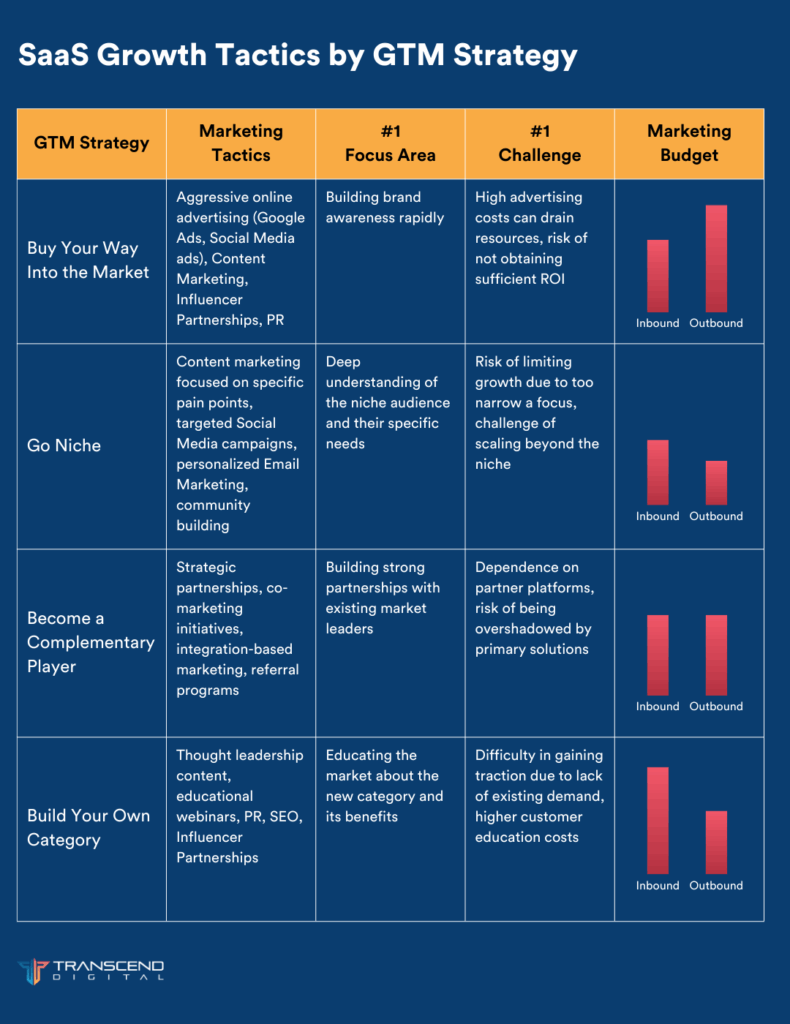
Buy Your Way into the Market
This one’s for all you big dreamers out there who aren’t afraid to go all in, break some rules, and make some noise. You’re not just looking to step into the market – you’re looking to take it by storm, turning heads and grabbing attention with your innovative product.
Here are some marketing tactics that can help you get there:
- Investing in paid advertising (Paid Search, LinkedIn, Quora, Meta, YouTube, Display) can help you reach a large audience quickly.
- Social media is a powerful tool to build thought leadership in your category and engage with your audience.
- Attending industry events (trade shows, conferences) will help you meet potential customers, partners, and investors.
- Partnering with influencers (yep, b2b influencers do exist) will help your brand gain traction quickly.
- Develop referral programs (offer discounts, free trials, or other incentives) to encourage people to refer their friends and colleagues.
- Use retargeting to target people who have already visited your website or engaged with your brand. They say it often takes six to eight touchpoints to create a viable sales lead.
Example
Let’s take a look at Monday.com as an excellent example of a startup using the “buy your way into the market” go-to-market strategy.
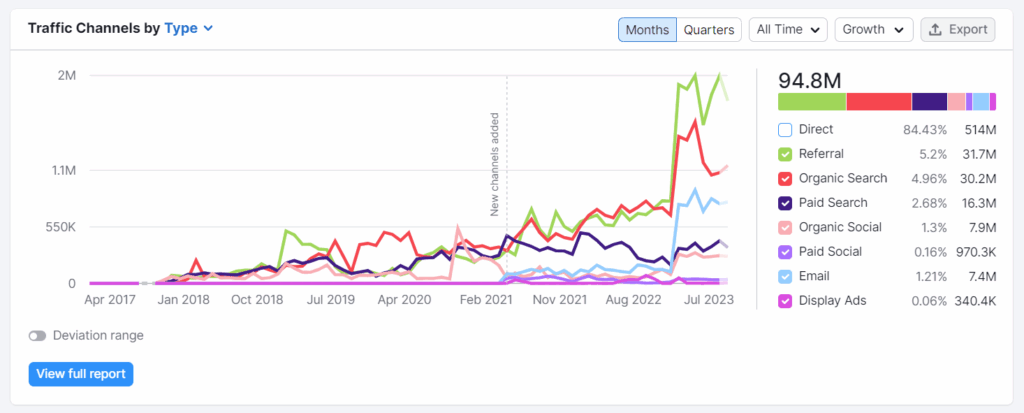
Monday.com, a work operating system (work OS) that powers teams to run projects and workflows with confidence, realized that to make a mark in the already crowded project management software market, they had to do something bold. They needed to get their name out there fast and make sure it stayed there.
They chose to invest heavily in highly visible online advertising. Whether it was Paid Search (including competitor conquesting!), YouTube, podcasts, LinkedIn, CTV, Monday.com was there. They poured millions into digital advertising and high-profile TV commercials, including a Super Bowl ad and sponsoring prime-time television shows. This aggressive advertising approach was aimed at quickly capturing a large market share.
Source: www.shovalfrenkel.com
The widespread advertising not only attracted a large number of users but also created a strong brand image. They made Monday.com a recognizable brand name in project management within a few short years.
Further Reading:
- How Most Startups Evaluate Marketing Agencies (and Why This Method is Flawed)
- SaaS Marketing Metrics Investors Want to See
- What is a Good Marketing Budget for a Startup?
Building Your Own Category
With this method, you’re not just bringing a new product to the market; you’re creating an entirely new market category that you alone occupy. You’re defining the rules and setting the standards.
Here are some marketing tactics that will help you succeed in building your own category go-to-market strategy:
- Since your category is new, your target audience may not yet be familiar with it. You need to educate them on what the category is, why it matters, and how your product or service fits into it. This can be done through content marketing, webinars, and thought leadership.
- In order to establish yourself as the leader in your new category, you need to be seen as a thought leader. This means publishing insightful content, speaking at industry events, and engaging with your target audience on social media.
- If you’re creating a new category, you may need to create a new language to describe it. This will help differentiate your product or service from competitors and create a sense of excitement and exclusivity.
- Look for companies that can complement your offering, build partnerships and work together to create a new ecosystem around your category.
- Building your own category can be a great story for the media. Invest in a PR strategy that can help you get coverage in relevant publications and build buzz around your brand.
Example
SparkToro, founded by Rand Fishkin (co-founder of Moz), is a perfect example of a startup that has adopted the “build your own category” strategy.
SparkToro’s journey began when Rand Fishkin, widely known in the SEO and digital marketing space, noticed a gaping hole in the market: marketers were struggling to understand where their audience spent time online. Traditional market research and analytics tools simply weren’t providing an accurate or detailed picture.
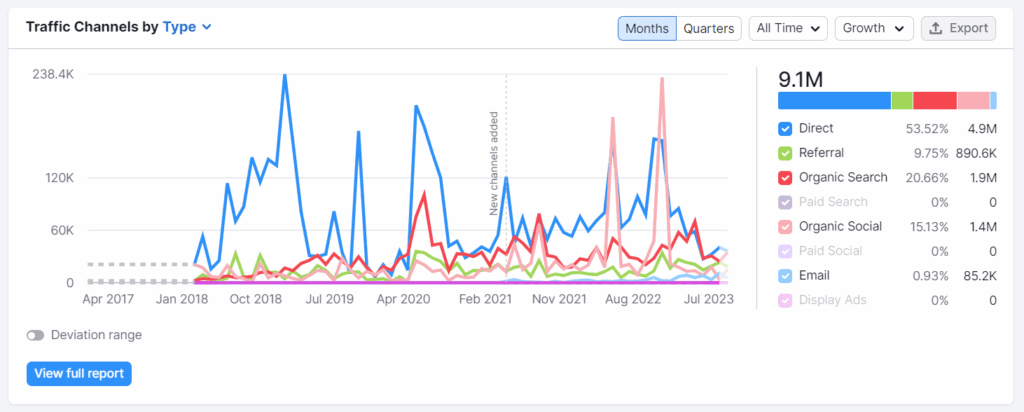
Rather than attempting to wedge themselves into an existing category, SparkToro decided to create a new one. They built a search engine that crawls social networks, websites, and podcasts to discover what any specific audience reads, listens to, watches, and follows. This was a new way to approach market research, enabling marketers to target their audience more accurately.
SparkToro’s content strategy is a pivotal part of their success, aimed at both educating the market about their unique offering and establishing themselves as thought leaders in their newly created category (more on creating an “audience intelligence” category here).
They maintain an in-depth blog that discusses industry trends, shares useful tips, and offers insights into how to make the most of their product. This content serves as a valuable resource for users looking to get more from their tool, and it also serves to draw in potential customers who stumble upon these resources in their online searches.
SparkToro also smartly leverages Rand Fishkin’s personal brand by featuring Fishkin in their content—webinars, interviews, blog posts, social media, and so forth.
Go Niche
This go-to-market strategy isn’t about casting a wide net and hoping for the best. It’s about honing in on a specific, underserved market and becoming the absolute best solution for that market’s unique needs.
Here are some marketing tactics that can help you succeed as a niche player:
- Deeply understand the specific needs and pain points of your target audience. This will help you position your product as the answer they’ve been waiting for.
- To reach your niche audience, you need to use targeted messaging that speaks directly to their needs and challenges. This can include using specific industry jargon, highlighting specific pain points, or showcasing how your product or service solves specific problems.
- Build a community around your brand. This can include creating a dedicated social media presence, hosting events, and engaging with your customers on a personal level.
- In a niche market, word-of-mouth referrals are crucial. By providing excellent customer service and support, you can build a loyal customer base that will refer others to your brand.
- Look for influencers and thought leaders within your niche market, and build relationships with them. This can help you reach a wider audience within your niche and establish your brand as a trusted solution provider.
Become a Complementary Player
There’s a saying: “If you can’t beat them, join them!”. The go-to-market strategy is the embodiment of this mantra in the SaaS world. It is all about positioning your product as an invaluable addition to an existing software ecosystem, whether it’s an indispensable plugin, a must-have extension, or a game-changing integration.
Here are some marketing tactics that can help you succeed as a complementary player:
- Identify existing players in the market segment or category you’re targeting, and look for opportunities to partner with them. This can help you leverage their brand and customer base, and position your offering as a natural complement to their product or service.
- If your product or service can integrate with existing solutions, it can become even more valuable to your target audience. Look for opportunities to create integrations with popular tools and platforms in your target market.
- In addition to your core product or service, consider offering value-added services that complement existing offerings. This can include training, consulting, or customization services.
- As a complementary player, you may not be the primary solution for your target audience. However, you can still use customer testimonials to show how your offering has helped them achieve their goals in conjunction with existing solutions.
- Position yourself as a thought leader, a trusted advisor in your market segment or category by publishing insightful content, speaking at industry events, and engaging with your target audience on social media.
We’ve got the compass, the map, and the crew!
And there you have it, an insider’s look at the go-to-market strategies for SaaS companies. The real magic happens when these strategies are infused with the right mix of messaging, creativity, expertise, and understanding of your audience and product.
Gearing up for launch? Ready to hit the gas on growth? Looking to leverage your successes for long-term sustainability? Our tailored growth marketing services can take you there. Let’s talk!



